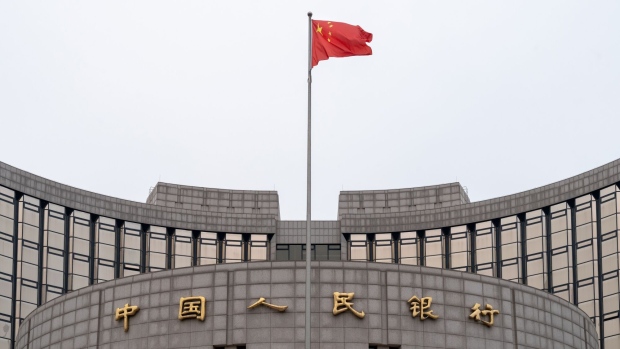Jan 24, 2024
PBOC Will Cut RRR for Banks in Early February, Governor Says
, Bloomberg News

(Bloomberg) -- China said it will cut the reserve requirement ratio for banks within two weeks and hinted at more support measures to come, an unusually early disclosure that shows mounting urgency across President Xi Jinping’s government to shore up the economy and halt a $6 trillion stock-market rout.
The RRR — which determines the amount of cash banks have to keep in reserve — will be lowered by 0.5 percentage points on Feb. 5 to provide 1 trillion yuan ($139 billion) in long-term liquidity to the market, the People’s Bank of China’s Governor Pan Gongsheng told reporters at a briefing.
Hours after the announcement, regulators added more measures to bolster the slumping property and stock markets. They broadened the use of commercial property loans for developers to help them repay other debt, and gave a boost to China and Hong Kong equities by unveiling steps to deepen financial ties with Hong Kong.
Read more: China Beefs Up Support for Developer Funding By Easing Loan Uses
The bank reserves move marked a rare and transparent reveal of a policy change by the head of the PBOC. Typically the central bank announces it on its website first, with the State Council — China’s cabinet — sometimes hinting at one beforehand. But troubling economic data and the massive rout in stocks have prompted authorities to step up rhetoric this week. Pan’s remarks add to a flurry of promises from other agencies following a call by Premier Li Qiang to stabilize the market.
“Announcing an RRR cut in advance suggests there’s no other effective tools available to stem the market rout,” said Shen Meng, managing director at Beijing-based Chanson & Co.
The Hang Seng China Enterprises Index extended gains following Pan’s remarks, capping its biggest two-day advance since November 2022. The yield on China’s 10-year government bonds slipped slightly before rebounding to 2.51%. The offshore yuan erased earlier losses amid state-bank sales of the US dollar.
While many economists had been expecting a RRR cut at some point this quarter, it’s not clear how much this will move the needle. Several analysts see the latest move as a way to smooth liquidity ahead of the Lunar New Year holiday next month, though any broader impact on the economy may be limited.
“An RRR cut helps sentiment in the sense that the action seems more decisive,” said Kevin Net, head of Asian equities at Tocqueville Finance SA. “But some investors may use this as an exit opportunity if there is such short-term market rebound — unless there are more policies to address structural issues, like those with the property market.”
Most of the other announcements this week have been fairly vague. The state-owned enterprise watchdog vowed to improve the quality of listed SOEs, while the securities regulator said it would “make every effort” to maintain the stable operation of capital markets and to calm investor nerves. Bloomberg News reported that authorities are mulling a $278 billion rescue package using offshore money as part of a stabilization fund. The plan hasn’t been finalized.
Along with the reserve ratio, Pan also said the central bank would from Thursday lower interest rates on relending funds provided to banks that incentivize loans to the agricultural sector and small firms.
The central bank later followed up on the pending cut, along with reductions in some relending rates, in a statement.
The upcoming RRR cut is also notable for its size. Over the past two years, the PBOC has reduced the ratio by a smaller 25 basis points, rather than the 50 announced by Pan. Lowering the ratio frees up liquidity, so that banks can extend loans to customers and buy more bonds to support economic growth. The central bank cut the RRR twice in 2023, with the last reduction in September.
Prior to Pan’s announcement, the PBOC’s actions had disappointed those hoping for more aggressive policy action. It left the rate on its one-year policy loans unchanged earlier this month, bucking widespread expectations for the first cut since August.
What Bloomberg Economics Says ...
“The central bank has provided over 1,600 billion yuan on net basis via its medium-term lending facility since November and 350 billion yuan via Pledged Supplemental Lending in December. The RRR cut will bring the total long-term cash injection to around 3 trillion yuan since November.”
— David Qu, economist
Read the full report here.
Concerns about yuan volatility and uncertainty over when the Federal Reserve would start cutting interest rates are considered to have limited the PBOC’s room for easing, though Pan on Wednesday noted signs of an impending pivot in the US. The narrowing of divergent policies between the world’s two largest economies “will expand space for China’s monetary policy operations,” he said, adding that the nation’s financial risks are manageable.
Pan said the PBOC will keep the yuan at a reasonable “equilibrium” level and ensure there is a balanced amount of credit. The yuan’s exchange rate will continue to be mainly determined by market, Pan added.
He also said households can afford to hold more government bonds, reiterating that the central government’s debt levels are not high. There’s significant scope to implement a proactive fiscal policy, he said.
The RRR cut is “another step in the right direction, but monetary policy by itself is not enough to boost economic momentum” said Zhiwei Zhang, president and chief economist at Pinpoint Asset Management Ltd. “A more proactive fiscal stance focusing on consumption is more important and effective.”
--With assistance from Zhu Lin, Wenjin Lv, Tian Chen, Charlotte Yang and Evelyn Yu.
(Updates with more measures in third paragraph.)
©2024 Bloomberg L.P.






